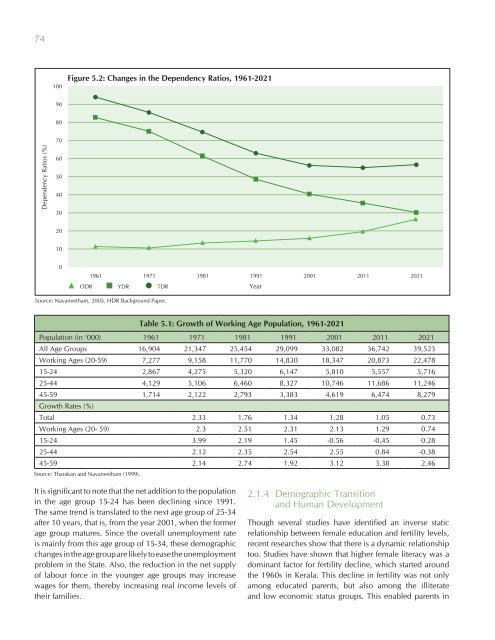Kerala 2005 - of Planning Commission
Kerala 2005 - of Planning Commission
Kerala 2005 - of Planning Commission
You also want an ePaper? Increase the reach of your titles
YUMPU automatically turns print PDFs into web optimized ePapers that Google loves.
74<br />
Table 5.1: Growth <strong>of</strong> Working Age Population, 1961-2021<br />
Population (in ‘000) 1961 1971 1981 1991 2001 2011 2021<br />
All Age Groups 16,904 21,347 25,454 29,099 33,082 36,742 39,523<br />
Working Ages (20-59) 7,277 9,158 11,770 14,830 18,347 20,873 22,478<br />
15-24 2,867 4,275 5,320 6,147 5,810 5,557 5,716<br />
25-44 4,129 5,106 6,460 8,327 10,746 11,686 11,246<br />
45-59 1,714 2,122 2,793 3,383 4,619 6,474 8,279<br />
Growth Rates (%)<br />
Total 2.33 1.76 1.34 1.28 1.05 0.73<br />
Working Ages (20- 59) 2.3 2.51 2.31 2.13 1.29 0.74<br />
15-24 3.99 2.19 1.45 -0.56 -0.45 0.28<br />
25-44 2.12 2.35 2.54 2.55 0.84 -0.38<br />
45-59 2.14 2.74 1.92 3.12 3.38 2.46<br />
Source: Tharakan and Navaneetham (1999).<br />
It is significant to note that the net addition to the population<br />
in the age group 15-24 has been declining since 1991.<br />
The same trend is translated to the next age group <strong>of</strong> 25-34<br />
after 10 years, that is, from the year 2001, when the former<br />
age group matures. Since the overall unemployment rate<br />
is mainly from this age group <strong>of</strong> 15-34, these demographic<br />
changes in the age group are likely to ease the unemployment<br />
problem in the State. Also, the reduction in the net supply<br />
<strong>of</strong> labour force in the younger age groups may increase<br />
wages for them, thereby increasing real income levels <strong>of</strong><br />
their families.<br />
2.1.4 Demographic Transition<br />
and Human Development<br />
Though several studies have identified an inverse static<br />
relationship between female education and fertility levels,<br />
recent researches show that there is a dynamic relationship<br />
too. Studies have shown that higher female literacy was a<br />
dominant factor for fertility decline, which started around<br />
the 1960s in <strong>Kerala</strong>. This decline in fertility was not only<br />
among educated parents, but also among the illiterate<br />
and low economic status groups. This enabled parents in

















